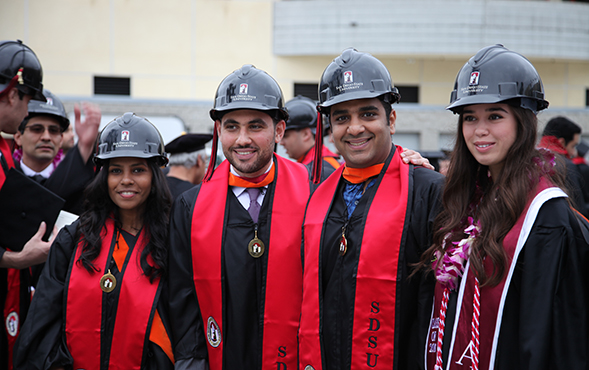Helping Students Ease on Down the Road
The National Science Foundation funded three education faculty members to research pathways to success for aspiring STEM students.

When students drop out of college, many assume they have failed. But San Diego State University researchers are turning that presumption on its head by asking how academic institutions can do a better job of keeping students on track toward graduation.
Three researchers from SDSU’s College of Education have been funded by the National Science Foundation (NSF) to study outcomes for aspiring STEM students in community colleges, where dropout rates are relatively high and the transition to a four-year institution can be complicated by curriculum misalignment and other obstacles outside the control of students.
J. Luke Wood and Frank Harris III, co-directors of the Minority Male Community College Collaborative (M2C3), and Felisha Herrera Villarreal, director of the Research & Equity Scholarship Institute, are working on separate but parallel research programs aimed at smoothing the path to STEM careers, particularly for underrepresented students.
Stephen Welter, vice president for research and dean of Graduate Affairs, said the importance of these programs cannot be overestimated.
"Evidence-based research identifying specific challenges and potential solutions to creating successful STEM pathways for underrepresented students are essential as universities strive to develop equal opportunities for student success in all disciplines," Welter said.
National and local
All three are faculty in the Department of Administration, Rehabilitation and Postsecondary Education, and Wood is also director of SDSU’s doctoral program in community college leadership.Their research is especially relevant in California, home to more than 10 percent of all community colleges in the United States. Nationwide, about 65 percent of black and Hispanic men begin their higher education in community colleges, but In California, that number exceeds 80 percent, Wood said.
He and Harris are working with researchers at the University of Illinois at Urbana-Champaign, the University of Michigan and Highline College in Des Moines, Washington.
The goal of their three-year, $1.6 million grant is to identify the best existing practices for teaching introductory calculus at the community college level. Calculus is often seen as a “bottleneck” course in STEM education, a point at which aspiring students veer from the STEM career course because calculus proves too difficult.
It’s a natural segue from Harris and Wood’s M2C3 project, which partners with colleges across the United States to increase the odds of success for male students of color.
White House advisers
“We’re very excited to see which of the existing methods are working best,” Wood said. “And this will be familiar territory for us since we’ve already worked with about a third of the community colleges in California through M2C3.”Wood said the new NSF award also advances research by Chris Rasmussen, an SDSU math professor affiliated with the Center for Research in Math and Science Education (CRMSE). Rasmussen’s NSF-funded work identified successful pedagogical approaches to calculus instruction at the middle and high school levels that could be applied to university instruction.
Harris and Wood’s research have garnered them national attention. They were advisers to former President Barack Obama’s White House Initiative on Educational Excellence for African Americans and participants in the October 2016 White House Conference on Inclusive STEM Education. Additionally, they were invited to participate in Obama’s My Brother’s Keeper initiative, which addresses “persistent opportunity gaps faced by boys and young men of color.”
Student mobility
Herrera Villarreal’s NSF award allows for the expansion of her seven-year body of STEM-related research at SDSU and, previously, at Oregon State University and the University of California, Los Angeles. She has examined the institutional policies and procedures that obstruct student advancement in the STEM disciplines.“My research seeks to understand students’ entire postsecondary experience and their transitions across multiple institutions,” Herrera Villarreal said. “For many students, the path to a STEM degree is not always straightforward.”
Her NSF-funded ED-SYSTEMS (Educational Settings Yielding Science, Technology, Engineering & Math Success) project is a large-scale national study that examines STEM pathways for students who begin at community colleges, with emphasis on underrepresented students and the role of minority serving institutions.
Personal experience
As director of the Research & Equity Scholarship Institute, Herrera Villarreal and fellow researchers partner with community colleges and other education organizations to better understand the entire educational experience—from pre-school through graduate and doctoral programs—and how institutions support students from diverse backgrounds.Herrera Villarreal’s personal story illustrates the challenges that can face transfer students: only 12 of the 64 credits she completed in community college transferred toward her bachelor’s degree. Since that time, community colleges and four-year institutions nationally have worked to better align their general education courses, but more work is needed to create seamless STEM pathways, she said.
“We need more STEM-focused bridge programs, more alliances like the MESA (Mathematics, Engineering, Science Achievement) program here at SDSU,” she said. “These facilitate the transition from community college to a four-year institution for underrepresented students.”



